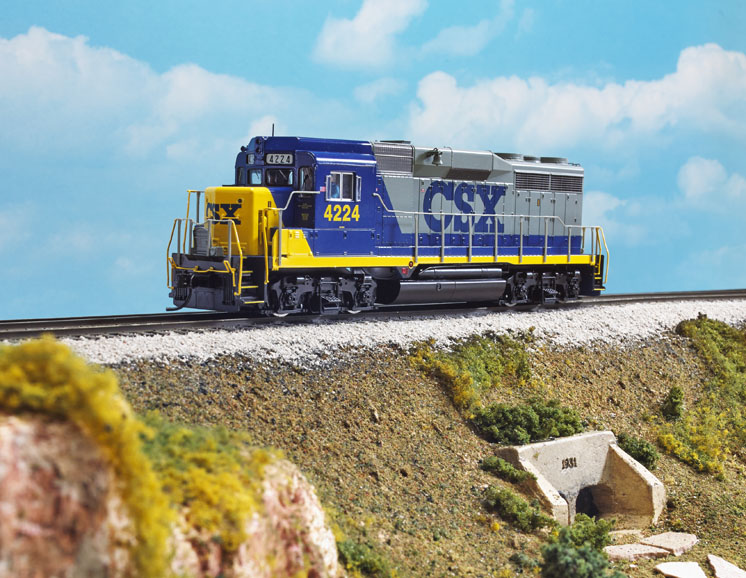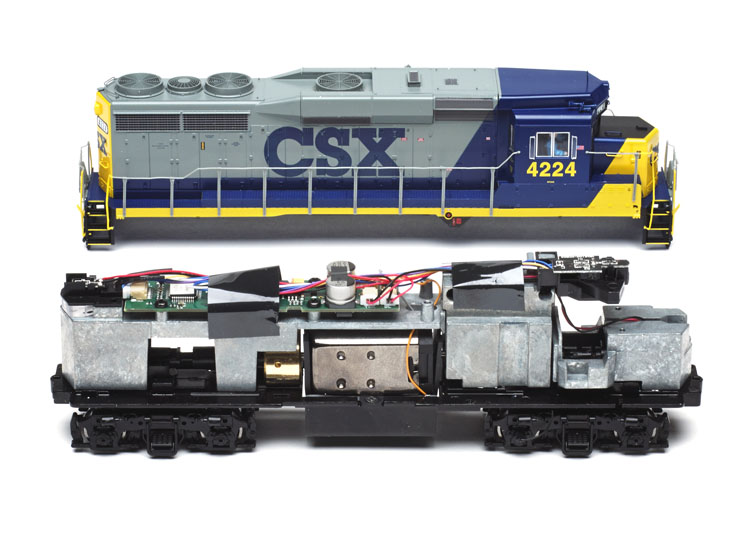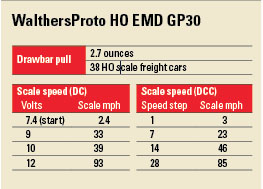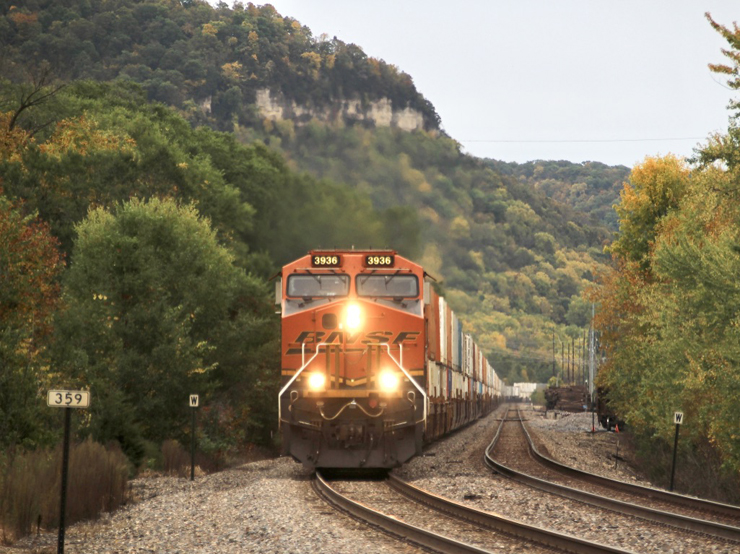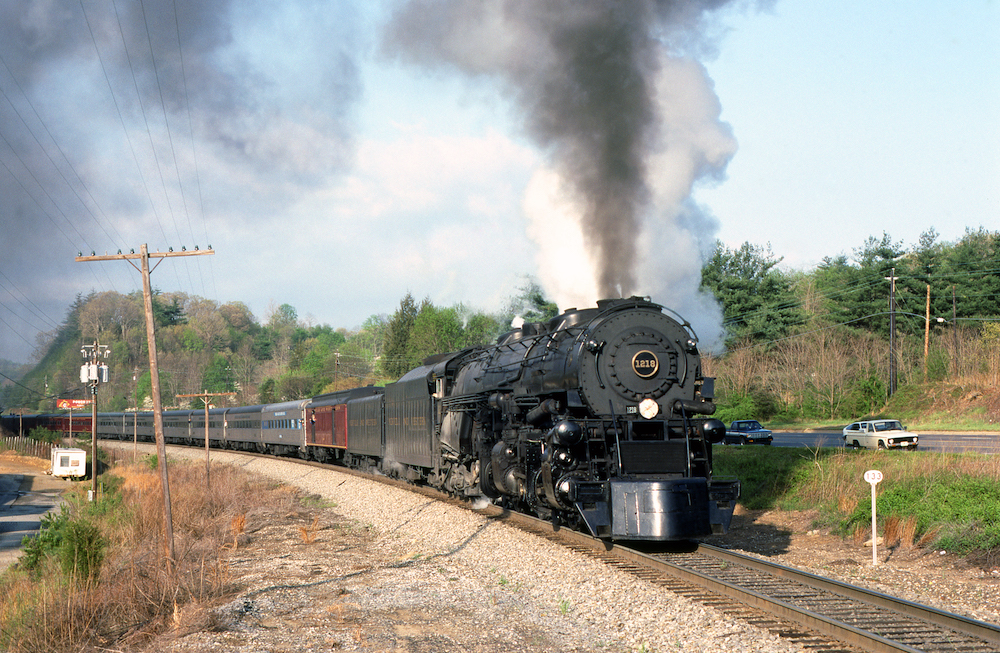Featuring a high level of protoypical detail and available with a SoundTraxx Tsunami Digital Command Control decoder, the WalthersProto HO scale GP30 captures the sights and sounds of its second-generation prototype. The decoder delivers realistic sound on direct-current and DCC layouts.
In the early 1960s, General Electric had severed ties with Alco and was about to debut its U25B road-switcher. The 2,500-hp unit would eclipse General Motors’ Electro-Motive Division’s 1,800 and 2,000-hp GP18s and -20s. GM didn’t have a 2,500-hp locomotive to sell.
Instead of continuing its short-lived practice of naming locomotives to indicate horsepower ratings, EMD decided the next model would be the GP30. It sported a 2,250-hp 567D3 V-16 engine and a distinctive fairing at the top of its carbody that helped integrate an electrical cabinet that was stuffed full of equipment to deal with the increased horsepower. The units sold well, with nearly 950 built from July 1961 to November 1963.
The WalthersProto GP30 matched dimensions I found in a 1962 EMD specifications book, and the CSX paint scheme matched photos I found online and in Brian Solomon’s book CSX.
The road numbers match CSX’s 1980s rebuilds classified as GP30Ms. The only detail discrepancy I noticed was the louvered battery box door. All the photos of CSX GP30s I found showed “mail slot” style battery box doors.
Etched-metal grills highlight the fan castings on the roof, and the radiator, electrical cabinet, and dynamic brake grills are painted with a gray wash to simulate open areas. The bell is mounted on the fireman’s side of the long hood on the front of the dynamic brake blister as per CSX practice.
Walkways have diamond tread detail and the plastic steps are perforated. The handrails are molded in flexible gray plastic with the railings at the ends painted yellow to match CSX paint schemes. There were some voids in the large CSX lettering on the side of the long hood, and the yellow paint on the sills and the nose is a little heavy, softening the detail molded into the shell. All the small lettering is neatly printed, and I could even count all 50 stars in the flag decals on the sides of the cab.
Under the hood a five-pole can motor and flywheel are mounted in the middle of the die-cast metal frame and drive all eight wheels through universal joints.
A die-cast metal weight is screwed on top of the frame. The electronics, including in our sample a SoundTraxx Tsunami dual-mode Digital Command Control (DCC) decoder, are screwed to the weight.
The WalthersProto GP30 was a solid performer in DCC. Using an NCE Power Cab, the locomotive started moving at 3 scale mph in speed step 1, topping out at 85 scale mph in speed step 28, just above the 83 mph the prototype could do with the highest gearing.
When I switched to 128 speed steps, the locomotive crawled along at just over 1 scale mph in speed step 1.
Over on the Wisconsin & Southern Troy Branch on Model Railroader’s Milwaukee, Racine & Troy club layout, the GP30 performed well. With the throttle set to 128 speed steps, I could ease the locomotive up to a cut of cars and stop just as the couplers locked.
Sound quality from the SoundTraxx Tsunami decoder enhanced the experience with the throb of EMD’s 567 diesel engine. The model had no trouble moving cuts of cars in and out of the yard and sidings on the layout.
Using an MRC Tech II powerpack, I found the locomotive didn’t perform quite as well on direct current (DC) at first. Engine sounds started up at 6V and the locomotive started moving jerkily at a little over 2 scale mph at just over 7V.
It didn’t smooth out until about 8V, at which point it ran smoothly at 3 scale mph. Following the SoundTraxx online users manual, I improved the DC slow speed operation by raising the analog start voltage in Configuration Variable (CV) 63 from a factory setting of 25 to 35. A DCC system or analog controller such as an MRC Tech 6 is required to program CVs. Note that different power packs may require different settings.
At up to 10 scale mph on our DC layout, the diesel’s bell rings, and the horn automatically sounds before starting forward, reversing, or stopping. A quick flick of the throttle triggered a grade-crossing warning of two long, one short, and one long blast. With a little practice, I was able to reverse direction without the sound dropping out and restarting. Top speed at 12V was a little high at 93 scale mph.
The GP30 was a landmark locomotive for EMD in the early 1960s. Serving into the 1990s on Class I railroads, these locomotives are still working for short lines and scenic railroads today. Anyone modeling the last 50 years could find a use for one on his layout.
Price: $299.98 with SoundTraxx dual-mode sound decoder, $199.98 direct current
Manufacturer
Wm. K. Walthers, Inc.
5601 W. Florist Ave.
Milwaukee, WI 53218
www.walthers.com
Era: 1963 to 1990s
Road names: CSX, Norfolk & Western, Southern, Union Pacific
Features
▪▪14:1 helical gears
▪▪Factory-installed metal grab irons and lift rings
▪▪Five-pole skew-wound can motor with flywheel
▪▪LED constant and directional headlights
▪▪Proto-Max metal knuckle couplers at correct height
▪▪Road-specific details
▪▪Weight: 13.1 ounces





